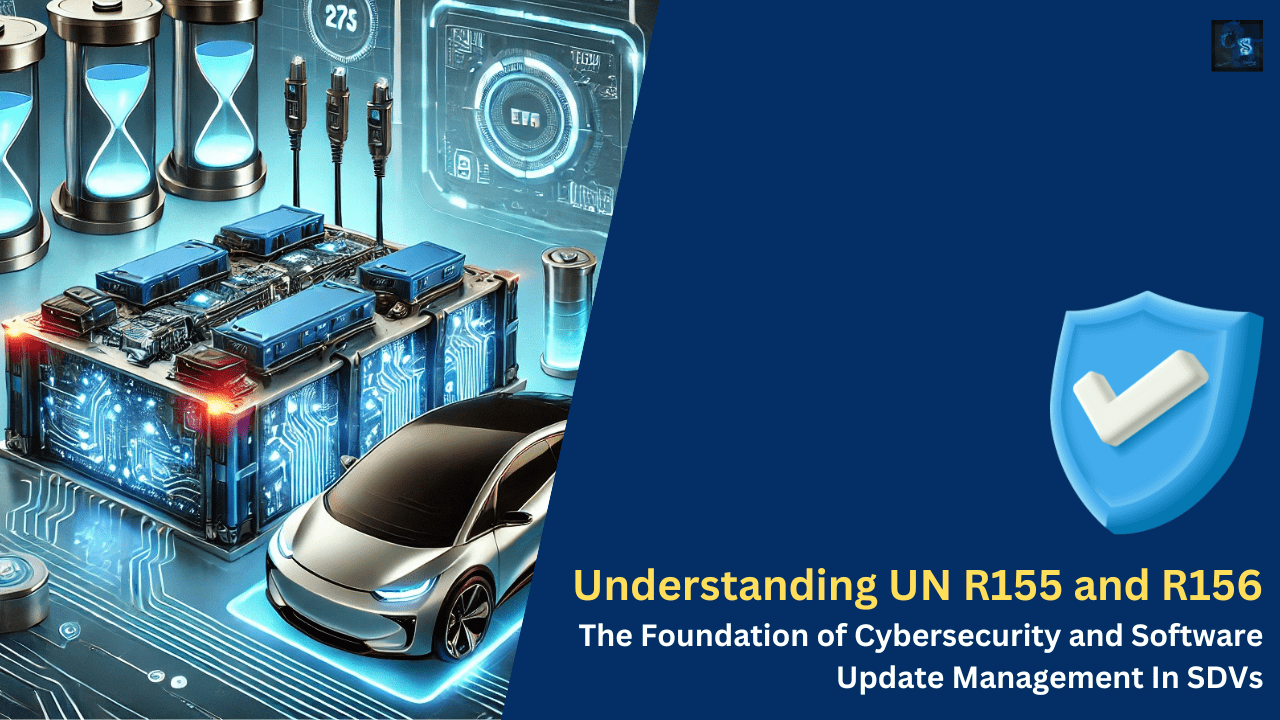Understanding UN R155 and R156: The Foundation of Cybersecurity and Software Update Management In SDVs
Hello guys, welcome back to our blog. In this article, I will discuss UN R155 and UN156 management in software-defined vehicles. Its impact on modern vehicles and challenges.
Ask questions if you have any electrical, electronics, or computer science doubts. You can also catch me on Instagram – CS Electrical & Electronics
- Functional Safety (ISO 26262) In Software-Defined Vehicle (SDV) Architecture
- Top Automotive Innovation And Advancement In China 2025
- Top 100 CAN, CAN-FD, CAN-TP Interview Questions With Answers
UN R155 and UN156 Management in Software-Defined Vehicles
The rapid transformation of the automotive industry into a connected and software-driven ecosystem has introduced unprecedented challenges in cybersecurity and software integrity. Modern vehicles now operate more like computers on wheels, equipped with various Electronic Control Units (ECUs), connectivity modules, and autonomous features. With the increased surface for cyber threats, ensuring the security and integrity of these systems is vital.
Recognizing this necessity, the United Nations Economic Commission for Europe (UNECE) introduced UN R155 and UN R156—two pivotal regulations addressing Cybersecurity Management Systems (CSMS) and Software Update Management Systems (SUMS), respectively. These regulations aim to standardize practices across manufacturers, suppliers, and software providers to secure the automotive ecosystem effectively.
Overview of UN R155: Cybersecurity Management System (CSMS)
What is UN R155?
UN R155 is a regulation focused on establishing cybersecurity management across the entire lifecycle of a vehicle. It mandates that automotive manufacturers implement a CSMS to identify, assess, and mitigate cyber threats to vehicles.
Core Objectives
- Protect vehicle systems from cyberattacks
- Detect and respond to security incidents
- Secure vehicle data and communications
- Ensure post-production cybersecurity support
CSMS Requirements
The regulation demands that manufacturers:
- Conduct Threat Analysis and Risk Assessment (TARA)
- Establish secure design principles
- Monitor and detect cybersecurity threats in the field
- Maintain a cybersecurity incident response plan
- Document all cybersecurity activities and updates throughout the vehicle lifecycle
Real-world Scenarios
For instance, a CSMS would protect against unauthorized access to a vehicle’s telematics system or malicious code injection into the infotainment system. Companies like Volkswagen and BMW have already adapted their processes to align with CSMS requirements.
Overview of UN R156: Software Update Management System (SUMS)
What is UN R156?
UN R156 addresses the increasing reliance on software updates in modern vehicles, particularly Over-the-Air (OTA) updates. The regulation mandates the implementation of a SUMS to manage and secure software changes effectively.
SUMS Core Objectives
- Prevent unauthorized software modifications
- Ensure traceability of software versions
- Provide secure update mechanisms
- Maintain a robust rollback and validation strategy
Requirements of SUMS
Manufacturers must:
- Maintain detailed software configuration and update records
- Verify software integrity before and after deployment
- Securely deliver updates using encryption and authentication
- Ensure compatibility and safety of updates
- Coordinate with suppliers for seamless software update integration
Real-world Applications
Tesla, for example, frequently deploys OTA updates to enhance vehicle features and fix bugs. UN R156 ensures that such updates are secure and well-documented.
UN R155 and R156 Certification Process
To comply with UN R155 and R156, OEMs must undergo audits and certification from authorized Technical Services. The process includes:
- Submitting detailed CSMS and SUMS documentation
- Demonstrating adherence to TARA and secure SDLC practices
- Providing evidence of threat detection, monitoring, and update validation mechanisms
- Ensuring supplier compliance
Comparison Between UN R155 and R156

Impact on Automotive Ecosystem
Impact on OEMs and Tier-1 Suppliers
OEMs are required to prove that both their internal processes and those of their suppliers align with the UN regulations. This often involves contractual changes and stringent process adaptations.
Impact on Vehicle Development Process
Vehicle development lifecycles now integrate cybersecurity and update management considerations at every phase, from design to post-production support.
Tools and Standards Used
- ISO/SAE 21434 for cybersecurity engineering
- ASPICE for process maturity
- AUTOSAR for standardizing software platforms
Challenges and Future Scope
Implementing CSMS and SUMS is not without challenges. These include:
- High complexity of threat modeling
- Coordinating across global supply chains
- Ensuring continuous compliance post-certification
The future scope may involve expanding these regulations to cover more vehicle categories and introducing newer standards like ISO 24089 for software update engineering.
Conclusion
UN R155 and R156 mark a significant milestone in the journey towards secure and future-ready vehicles. These regulations ensure that cybersecurity and software update management are not afterthoughts but integral to vehicle design and operation. As vehicles become more connected and autonomous, compliance with these regulations will become a competitive advantage, ensuring safety, trust, and long-term brand loyalty in the automotive world.
This was about “Understanding UN R155 and R156: The Foundation of Cybersecurity and Software Update Management In SDVs“. Thank you for reading.
Also, read:
- 100 (AI) Artificial Intelligence Applications In The Automotive Industry
- 2024 Is About To End, Let’s Recall Electric Vehicles Launched In 2024
- 50 Advanced Level Interview Questions On CAPL Scripting
- 7 Ways EV Batteries Stay Safe From Thermal Runaway
- 8 Reasons Why EVs Can’t Fully Replace ICE Vehicles in India
- A Complete Guide To FlexRay Automotive Protocol
- Adaptive AUTOSAR Vs Classic AUTOSAR: Which One For Future Vehicles?
- Advanced Driver Assistance Systems (ADAS): How To Become An Expert In This Growing Field

